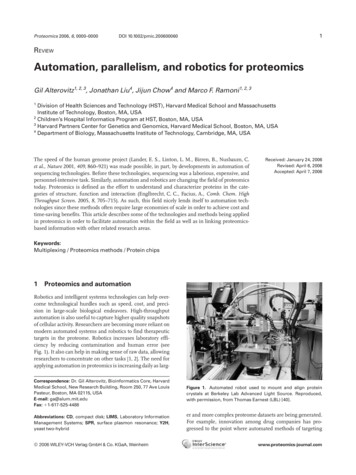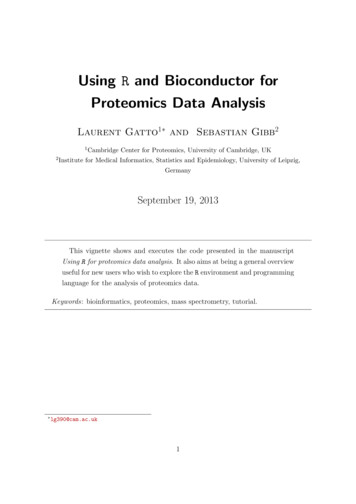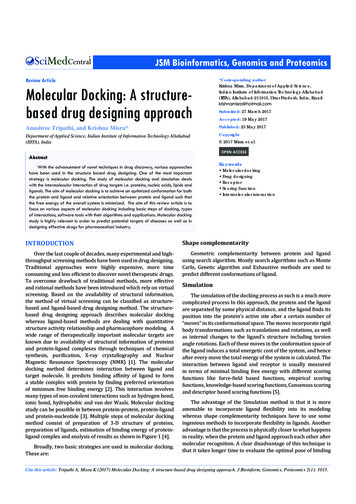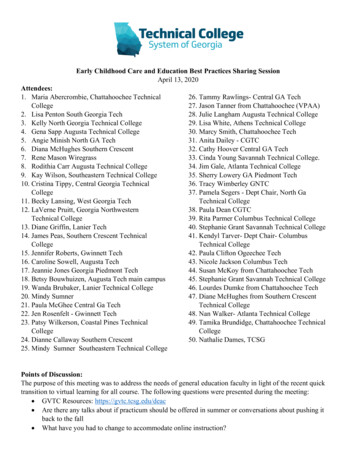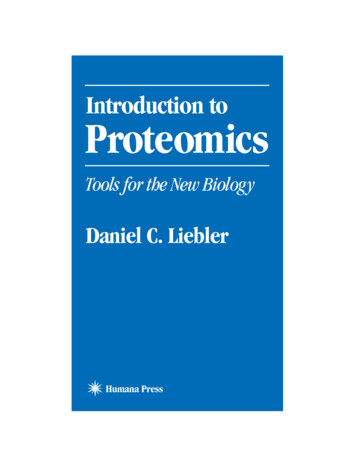
Transcription
Introduction toProteomicsTools for the New BiologyDaniel C. LieblerHumana Press
iINTRODUCTION TO PROTEOMICS
ii
iiiIntroduction to ProteomicsTools for the New BiologyByDANIEL C. LIEBLER, PhDCollege of PharmacyThe University of ArizonaTucson, AZForeword byJOHN R. YATES, III, PhDDepartment of Cell BiologyThe Scripps Research InstituteLa Jolla, CAHumana PressTotowa, NJ
iv 2002 Humana Press Inc.999 Riverview Drive, Suite 208Totowa, New Jersey 07512humanapress.comFor additional copies, pricing for bulk purchases, and/or information about other Humanatitles, contact Humana at the above address or at any of the following numbers: Tel.: 973-256-1699;Fax: 973-256-8341, E-mail: humana@humanapr.com; or visit our Website at: www.humanapr.comAll rights reserved.No part of this book may be reproduced, stored in a retrieval system, or transmitted in any formor by any means, electronic, mechanical, photocopying, microfilming, recording, or otherwisewithout written permission from the Publisher. The content and opinions expressed in this bookare the sole work of the authors and editors, who have warranted due diligence in the creationand issuance of their work. The publisher, editors, and authors are not responsible for errors oromissions or for any consequences arising from the information or opinions presented in thisbook and make no warranty, express or implied, with respect to its contents.Cover design by Patricia Cleary.Production Editor: Kim Hoather-Potter.This publication is printed on acid-free paper. ANSI Z39.48-1984 (American National Standards Institute) Permanence of Paper for PrintedLibrary Materials.Photocopy Authorization Policy:Authorization to photocopy items for internal or personal use, or the internal or personal use ofspecific clients, is granted by Humana Press Inc., provided that the base fee of US 10.00 percopy, plus US 00.25 per page, is paid directly to the Copyright Clearance Center at 222Rosewood Drive, Danvers, MA 01923. For those organizations that have been granted a photocopy license from the CCC, a separate system of payment has been arranged and isacceptable to Humana Press Inc. The fee code for users of the Transactional Reporting Serviceis: [0-89603-991-9/02 10.00 00.25].Printed in the United States of America. 10 9 8 7 6 5 4 3 2 1Library of Congress Cataloging-in-Publication DataLiebler, Daniel C.Introduction to proteomics: tools for the new biology/Daniel C. Liebler.p. cm.Includes bibliographical references and index.ISBN 0-89603-991-9 (HC), ISBN 0-89603-992-7 (PB) (alk. paper)1. Proteins—Research—Methodology. I. Title.QP551.L467 2002572'.6'072—dc212001051465
vForewordMass spectrometry has evolved tremendously since Professor KlausBiemann first analyzed amino acids in a mass spectrometer in 1958.The clear challenge in Biemann’s first experiment was how to introduce nonpolar molecules into the mass spectrometer to create ions. Inthe years since 1958, several new ionization techniques and sampleintroduction methods appeared and stimulated much progress in theanalysis of biomolecules. As these new ionization techniques, such aschemical ionization, field desorption, field ionization, plasma desorption, and finally fast atom bombardment (FAB) emerged, new methodsfor peptide and protein characterizations also developed. Mass spectrometry technology leapt forward in 1987 with the introduction ofmatrix-assisted laser desorption ionization (MALDI) and the application of electrospray ionization (ESI) to biomolecules. Both ionizationmethods led to dramatic improvements in the analysis of peptides andproteins. A key mass spectrometry technique that benefited from thenew ionization methods was tandem mass spectrometry.In the early 1980s Professor Donald Hunt began developing andapplying tandem mass spectrometry to the sequence analysis of peptides and proteins. FAB, a soft ionization technique, created intact protonated molecules and allowed the refinement of approaches for peptidesequencing. FAB was a major breakthrough for peptide sequencing,because peptides could now be readily ionized without derivatizationto increase volatility. By incorporating FAB with tandem mass spectrometry, a rapid peptide sequencing methodology was developed.Most approaches used off-line HPLC separations when complicatedpeptide mixtures were encountered. Many proteins were sequencedby this approach and many important methods were developed.Unfortunately, on-line coupling of separation methods with FAB wasnever able to create a robust, easy-to-use method. This problem wasn’tresolved until electrospray ionization facilitated the direct coupling ofseparation techniques to the mass spectrometer. All aspects of peptideand protein analyses were improved by increases in the sensitivity ofanalysis, easier sample handling, and automation.v
viForewordThese developments in mass spectrometry dovetailed very nicelyinto the worldwide efforts to sequence the human genome. Thegenome sequencing efforts encompassed not only the human genome,but also genomes of many model organisms and have resulted in thegeneration of a large amount of sequence information. In 1993 severalgroups discovered that mass spectrometry data could be used to searchdatabases to identify the protein under study. In 1994 methods to searchsequence databases using tandem mass spectrometry data weredeveloped allowing one to “look up the answer in the back of the book.”If the “book” was an organism whose genome was sequenced, thenthe answer was most assuredly in the back. The complex issues of posttranslational modifications and amino acid sequence variations can alsobe addressed by knowing the sequences of proteins from a genomesequence.Interest in and use of mass spectrometry in the biological scienceshas grown rapidly during the 1990s and threatens to become as ubiquitous and important as SDS-PAGE in the new millennium. Biologistswill come to rely on mass spectrometry to determine the outcomes oftheir experiments. Given the need for biologists to use mass spectrometry technology to analyze their experiments, how does a biologist learnabout the art of mass spectrometry and the methods of proteomics?This book, Introduction to Proteomics: Tools for the New Biology by Professor Daniel Liebler, presents a tutorial on mass spectrometry and itsuse in proteomics. The basics of mass spectrometers and ionizationtechniques are described, which is important to ascertain what type ofmass spectrometer is most appropriate for a particular study. The ability to use mass spectrometry data to search databases is an importantadvance for the nonspecialist, because it no longer requires the development of the skills to interpret mass spectra. A basic understandingof the fundamentals of the search algorithms and their limitations isdescribed in the book. Finally, applications of mass spectrometry toproteomics are described. This book provides an excellent introductionand overview of proteomics for the graduate student or for any biologist interested in understanding the basics of this rapidly evolving area.John R. Yates, IIIScripps Research InstituteLa Jolla, CA
viiPrefaceThis book is an introduction to the new field of proteomics. It isintended to describe how proteins and proteomes can be analyzed andstudied. Despite widespread, growing interest in proteomics, anunderstanding of proteomics tools and technologies is only slowly penetrating the research community at large. This book addresses the needto introduce biologists to new tools and approaches, and is for bothstudents of biology and experienced, practicing biologists. Anyone whohas taken a graduate level biochemistry course should be able to takefrom this book a reasonable understanding of what proteomics is allabout and how it is practiced. The experienced biologist should encounter much here that is familiar, but refocused to facilitate studies ofthe proteome.The achievement of long-sought milestones in genome sequencing,analytical instrumentation, computing power, and user-friendly softwaretools has irrevocably changed the practice of biology. After years of studying the individual components of living systems, we can now study thesystems themselves in comprehensive scope and in exquisite moleculardetail. We therefore face the tasks of effectively employing new technologies, of dealing with mountains of data, and, most important, ofadjusting our thinking to understand complex systems as opposed totheir individual components.Introduction to Proteomics: Tools for the New Biology had its origins in ashort course on peptide sequencing by mass spectrometry, which wastaught by Dr. Donald F. Hunt at the 1998 Association of BiomedicalResource Facilities meeting in Durham, North Carolina. At that time,my colleague Dr. Tom McClure and I were establishing a new proteomicsfacility in the Center for Toxicology and the Arizona Cancer Center atthe University of Arizona. Tom attended the Hunt course and, upon hisreturn, taught the material to a handful of us. We subsequently puttogether a four-day workshop on mass spectrometry and proteomics,which we taught to 50 participants at the University of Arizona inAugust, 1999. The participants included graduate students, laboratorystaff, and faculty. The enthusiastic response to this workshop reflectedthe need for some accessible means of introducing scientists to the newvii
viiiPrefacetechniques of proteomics and their potential applications in research.That experience provided the impetus for this book.This is a book for beginners. My goal here is to familiarize the inexperienced reader with the important tools and applications of proteomics.Thus the description of certain instrumentation and applications is nothighly rigorous. This book is not intended to be a laboratory manual ora compilation of the latest techniques. There are several excellent volumes available that provide more detailed descriptions of protein analytical techniques, mass spectrometry instrumentation and techniques,and applications of these technologies. The evolution of methods andapplications in this area is now so rapid that no book really could betruly up-to-date. What is exciting about my experience in introducingproteomics to colleagues has been the creativity with which they thenapply these tools. Ultimately, the exciting potential of proteomics restswith those who can put new technologies to work to address important questions.I have divided the book into three parts. Part I introduces the subject of proteomics, describes its place in the new biology, and examinesthe nature of proteomes. Part II introduces the tools of proteomicsresearch and explains how they work. Part III explains how these toolsare integrated to solve different types of problems in biology.I would like to thank Jeanne Burr, Laura Tiscareno, Julie Jones, DanMason, Beau Hansen, Hamid Badghisi, Linda Manza, RichardVaillancourt, Tom McClure, Arpad Somogyi, and George Tsaprailis, whoprovided valuable suggestions, read and commented on several draftsof book chapters and provided sample data for some of the illustrations.I thank Elizabeth Hedger for excellent secretarial assistance. Finally, Ithank my wife Karen and my son Andrew for their patience with meevery time I went off with my laptop to write.Daniel C. Liebler, PhD
huangzhiman 2002.12.19ixContentsForeword by J. R. Yates, III . vPreface . viiI.Proteomics and the Proteome .11. Proteomics and the New Biology .32. The Proteome . 15II.Tools of Proteomics . 253. Overview of Analytical Proteomics . 274. Analytical Protein and Peptide Separations .315. Protein Digestion Techniques .496. Mass Spectrometers for Protein and Peptide Analysis . 557. Protein Identification by Peptide Mass Fingerprinting . 778. Peptide Sequence Analysis by TandemMass Spectrometry . 899. Protein Identification with Tandem MassSpectrometry Data . 9910. SALSA: An Algorithm for Mining Specific Featuresof Tandem MS Data . 109III. Applications of Proteomics .12311. Mining Proteomes .12512. Protein Expression Profiling . 13713. Identifying Protein–Protein Interactionsand Protein Complexes .15114. Mapping Protein Modifications . 16715. New Directions in Proteomics .185Index . 195ix
Proteomics and New BiologyIProteomicsand the Proteome1
2Proteomics and the Proteome
Proteomics and New Biology13Proteomics and the NewBiology1.1. The New BiologyProteomics is the study of the proteome, the protein complement ofthe genome. The terms “proteomics” and “proteome” were coined byMarc Wilkins and colleagues in the early 1990s and mirror the terms“genomics” and “genome,” which describe the entire collection ofgenes in an organism. These “-omics” terms symbolize a redefinitionof how we think about biology and the workings of living systems(Fig. 1). Until the mid-1990s, biochemists, molecular biologists, and cellbiologists studied individual genes and proteins or small clusters ofrelated components of specific biochemical pathways. The techniquesthen available—Northern blots (for gene expression) and Westernblots (for protein levels)—made charting the status of more than ahandful of genes or proteins a formidable analytical task.Three developments changed the biological landscape and formedthe foundation of the new biology. The first was the growth of gene,expressed sequence tag (EST), and protein-sequence databases duringthe 1990s. These resources became ever more useful as partial catalogsof expressed genes in many organisms. The genome-sequencingprojects of the late 1990s yielded complete genomic sequences ofbacteria, yeast, nematodes, and drosophila and culminated recentlyin the complete sequence of the human genome. Sequences of plantgenomes and those of other widely studied animals also are recentlycompleted or are approaching completion. These genome-sequenceFrom: Introduction to Proteomics: Tools for the New BiologyBy: D. C. Liebler Humana Press, Inc., Totowa, NJ3
4Proteomics and the ProteomeFig. 1. Biochemical context of genomics and proteomics.databases are the catalogs from which much of our understanding ofliving systems eventually will be extracted.The second key development is the introduction of user-friendly,browser-based bioinformatics tools to extract information from thesedatabases. It is now possible to search entire genomes for specificnucleic acid or protein sequences in seconds. Such database searchtools are integrated with other tools and databases to predict thefunctions of the protein products based on the occurrence of specificfunctional domains or motifs. This array of free web-based tools nowenables the biologist to probe structures and functions of genes andgene products and to explore a great deal of interesting biochemistryright from a desktop computer.The third key development is the oligonucleotide microarray. Thearray contains a series of gene-specific oligonucleotides or cDNAsequences on a slide or a chip. By applying a mixture of fluorescentlylabeled DNAs from a sample of interest to the array, one can probe
Proteomics and New Biology5Fig. 2. The yeast genome on a chip. This yeast cDNA microarraywas produced by the laboratory of Dr. Patrick Brown at StanfordUniversity (http://cmgm.stanford.edu/pbrown/).the expression of thousands of genes at once. One array can replacethousands of Northern-blot analyses and can be done in the time itwould take to do one Northern. Moreover, with two-color fluorescentprobe labeling, expression of genes in two different samples can becompared directly on one slide or chip.An array slide containing unique sequences for each of the 6000genes in the Sacchromyces cerevisiea genome is pictured in Fig. 2. From
6Proteomics and the Proteomethis single array, one can assess the expression of all genes in the yeastgenome. Such pictures vividly confront us with the greatest challengeof the new biology. We can see the whole system, but the informationcontained in these thousands of data points is beyond our abilityto interpret intuitively. New clustering algorithms, self-organizingmaps, and similar tools represent the latest approaches to renderingthe data in ways that biologists can comprehend.The most important thing about arrays in this context is that theyhave challenged biologists to think big. A cell has thousands or tens ofthousands of genes that may be expressed in varying combinations.The life and death of cells is dictated by the expression of these genesand the activities of their protein products. Each protein, whether atransmembrane receptor, a transcription factor, a protein kinase, or achaperone, expresses a function that assumes significance only in thecontext of all the other functions and activities also being expressedin the same cell. Thus, biologists are now struggling to think big,to understand systems rather than just components, and to makesense of complexity.1.2. Proteomics? That’s Just What We Usedto Call Protein Chemistry!A common response to new ideas, terms, and approaches is to claimthat they are not really new after all. For this reason, it is importantto explain just what are the differences between proteomics andprotein biochemistry. Both proteomics and protein chemistry involveprotein identification, so what’s the difference? Table 1 provides ashort summary of the key features to consider. Protein chemistryinvolves the study of protein structure and function and is mostcommonly manifest in the fields of physical biochemistry or mechanistic enzymology. The work generally involves complete sequenceanalysis, structure determination, and modeling studies to explorehow structure governs function. Physical biochemists and enzymologists typically study one protein or multisubunit protein complexat a time.Proteomics is the study of multiprotein systems, in which the focusis on the interplay of multiple, distinct proteins in their roles as partof a larger system or network. Analyses are directed at complexmixtures and identification is not by complete sequence analysis,
Proteomics and New Biology7Table 1Differences Between Protein Chemistry and ProteomicsProtein chemistry Individual proteins Complete sequence analysis Emphasis on structure and function Structural biologyProteomics Complex mixtures Partial sequence analysis Emphasis on identificationby database matching Systems biologybut instead by partial sequence analysis with the aid of databasematching tools. The context of proteomics is systems biology, ratherthan structural biology. In other words, the point of proteomics isto characterize the behavior of the system rather than the behaviorof any single component.1.3. If We Can Measure Gene Expression, WhyBother With Proteomics?Gene microarrays offer a snapshot of the expression of many or allgenes in a cell. Unfortunately, the levels of mRNAs do not necessarilypredict the levels of the corresponding proteins in a cell. Differingstability of mRNAs and different efficiencies in translation canaffect the generation of new proteins. Once formed, proteins differsignificantly in stability and turnover rates. Many proteins involvedin signal transduction, transcription-factor regulation, and cell-cyclecontrol are rapidly turned over as a means of regulating their activities.Finally, mRNA levels tell us nothing about the regulatory statusof the corresponding proteins, whose activities and functions aresubject to many endogenous posttranslational modifications andother modifications by environmental agents.1.4. Proteomics: An Analytical ChallengeThe problem of how to measure the expression of many or all of thegenes in an organism simultaneously seems to have been solved bythe introduction of cDNA or oligonucleotide microarrays. Analysisof gene expression by microarrays and related methods relies on twoessential tools, polymerase chain reaction (PCR) and hybridization of
8Proteomics and the Proteomeoligonucleotides to complementary sequences. Unfortunately, thereare no analogous tools available for protein analysis. First, thereis no protein equivalent of PCR. It is not currently possible to inducepolypeptide molecules to replicate themselves in a manner analogous to oligonucleotide replication through PCR. Whereas a smallamount of oligonucleotide can be amplified through PCR, a smallamount of a polypeptide must be detected and analyzed withoutany amplification.Second, proteins do not specifically hybridize to complementaryamino acid sequences. Watson-Crick base-pairing allows oligonucleotides to hybridize to complementary sequences. A defined complementary oligonucleotide sequence can serve as a highly specificprobe to which a specific mRNA or other nucleic acid fragment canbind. This specificity allows a particular spot on the microarray torecognize a unique sequence. Although antibodies and oligonucleotideaptamers can recognize specific peptides or proteins, recognitioncannot be predicted simply on the basis of sequence, as it can foroligonucleotides.Another problem peculiar to proteomics is that each protein geneproduct does not necessarily give rise to only one molecular entity inthe cell. This is because proteins are posttranslationally modified. Theextent and variety of modification varies with individual proteins,regulatory mechanisms within the cell, and environmental factors.Consequently, many proteins are present in multiple forms. Thenecessity of detecting and differentiating between multiple proteinproducts of any particular gene adds much to the analytical challengeof proteomics.Analysis of the proteome thus requires a different set of toolsthan does gene-expression analysis. The task of characterizing theproteome requires analytical methods to detect and quantify proteinsin their modified and unmodified forms. How we deal with this taskis the subject of this book.1.5. Tools of ProteomicsDespite the relative disadvantages of analytical proteomics describedearlier, the task of characterizing the proteome and its componentsis now practically achievable. This is because the development andintegration of four important tools provide investigators with sensitive,specific means of identifying and characterizing proteins.
Proteomics and New Biology9The first tool is the database. Protein, EST, and complete genomesequence databases collectively provide a complete catalog of allproteins expressed in organisms for which the databases are available.Based on analyses of all the coding sequences for Drosophila, forexample, we know that there are 110 Drosophila genes that code forproteins with EGF-like domains and 87 genes that code for proteinswith tyrosine kinase catalytic domains. Accordingly, when doingproteomics in Drosophila, we are searching a large, but known index ofpossible proteins. When searched with limited sequence informationor even raw mass spectral data (see below), we can identify a proteincomponent from a match with a database entry.The second tool is mass spectrometry (MS). MS instrumentationhas undergone tremendous change over the past decade, culminatingin the development of highly sensitive, robust instruments that canreliably analyze biomolecules, particularly proteins and peptides. MSinstrumentation can offer three types of analyses, all of which arehighly useful in proteomics. First, MS can provide accurate molecularmass measurements of intact proteins as large as 100 kDa or more.Thus, MS analysis, rather that migration on sodium dodecyl sulfatepolyacrylamide gel electrophoresis (SDS-PAGE) is the best way toestimate protein masses. Highly accurate protein mass measurementsgenerally are of limited utility, however, because they often are notsufficiently sensitive and because net mass often is insufficient forunambiguous protein identification. MS also can provide accuratemass measurements of peptides from proteolytic digests. In contrastto whole protein mass measurements, peptide mass measurementscan be done with higher sensitivity and mass accuracy. The datafrom these peptide mass measurements can be searched directlyagainst databases, frequently to obtain definitive identification of thetarget proteins. Finally, MS analyses can provide sequence analysisof peptides obtained from proteolytic digests. Indeed, MS is nowconsidered the state-of-the-art in peptide-sequence analysis. MSsequence data provide the most powerful and unambiguous approachto protein identification.The third essential tool for proteomics is an emerging collection ofsoftware that can match MS data with specific protein sequences indatabases. As noted earlier, it is possible to determine the sequence ofa peptide from MS data. However, this de novo sequence interpretation is a relatively laborious task, particularly when one has to
10Proteomics and the Proteomeinterpret hundreds or thousands of spectra. These software tools takeuninterpreted MS data and match it to sequences in protein, EST, andgenome-sequence databases with the aid of specialized algorithms.The most useful aspect of these tools is that they permit the automatedsurvey of large amounts of MS data for protein-sequence matches. Theinvestigator then can inspect the results and evaluate the quality ofthe data in far less time than it would take to interpret each spectrummanually.The fourth essential tool in proteomics is analytical protein-separationtechnology. Protein separations serve two purposes in proteomics.First, they simplify complex protein mixtures by resolving them intoindividual proteins or small groups of proteins. Second, because theyalso permit apparent differences in protein levels to be comparedbetween two samples, protein analytical separations allow investigators to target specific proteins for analysis. Certainly, two-dimensionalSDS-PAGE (2D-SDS-PAGE) is most widely associated with proteomics.Two-dimensional gels represent perhaps the best single techniquefor resolving proteins in a complex sample. However, other proteinseparation techniques, including 1D-SDS-PAGE, high-performanceliquid chromatography (HPLC), capillary electrophoresis (CE), isoelectric focusing (IEF), and affinity chromatography all can be usefultools in analytical proteomics. Perhaps most powerful is the integration of different protein and peptide separations as multidimensionaltechniques. For example, ion-exchange liquid chromatography (LC) intandem with reverse-phase (RP)-HPLC is a powerful tool for resolvingcomplex peptide mixtures.It is the integration of these four tools that provides the currenttechnology of proteomics. Each of these capabilities is rapidly evolvingfrom a technical standpoint. We will consider each of these sets ofanalytical tools in subsequent chapters in this book.1.6. Applications of ProteomicsProteomics technology is indeed impressive, but what does characterizing the proteome amount to in practical terms? In currentpractice, proteomics encompasses four principal applications. Theseare: 1) mining, 2) protein-expression profiling, 3) protein-network
Proteomics and New Biology11mapping, and 4) mapping of protein modifications. These each willbe defined briefly below and in detail in subsequent chapters inthis book.Mining is simply the exercise of identifying all (or as many aspossible) of the proteins in a sample. The point of mining is to catalogthe proteome directly, rather than to infer the composition of theproteome from expression data for genes (e.g., by microarrays). Miningis the ultimate brute-force exercise in proteomics: one simply resolvesproteins to the greatest extent possible and then uses MS and associated database and software tools to identify what is found. There areseveral approaches to mining and each offers advantages. What theseapproaches collectively offer is the ability to confirm by direct analysiswhat could only be inferred from gene-expression data.Protein-expression profiling is the identification of proteins in aparticular sample as a function of a particular state of the organismor cell (e.g., differentiation, developmental state, or disease state) oras a function of exposure to a drug, chemical, or physical stimulus.Expression profiling is actually a specialized form of mining. It ismost commonly practiced as a differential analysis, in which twostates of a particular system are compared. For example, normal anddiseased cells or tissues can be compared to determine which proteinsare expressed differently in one state compared to the other. Thisinformation has tremendous appeal as a means of detecting potentialtargets for drug therapy in disease.Protein-network mapping is the proteomics approach to determining how proteins interact with each other in living systems. Mostproteins carry out their f
Dec 19, 2002 · ject of proteomics, describes its place in the new biology, and examines the nature of proteomes. Part II introduces the tools of proteomics research and explains how they work. Part III explains how these tools are integrated to solve different types of problems in biology. I would lik

